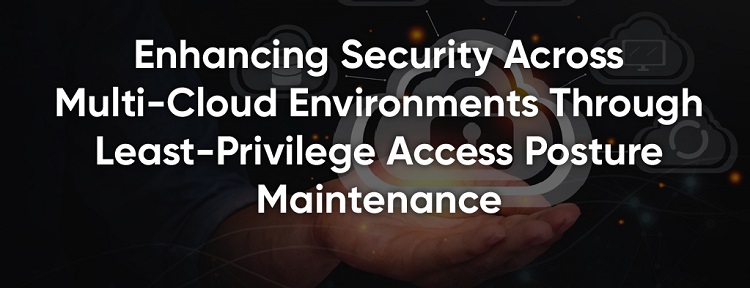In today’s era of digital transformation, the adoption of multi-cloud strategies is becoming increasingly prevalent. Organizations often leverage multiple cloud service providers to optimize their operations, enhance scalability, and diversify risks. However, this approach introduces complexities in managing access rights and privileges across varied environments. A centralized identity management system, like single sign-on (SSO) solutions, ensures seamless and consistent user identities across platforms. Simultaneously, automated policy enforcement and regular audits are pivotal in maintaining uniformity in access policies across cloud platforms. It’s also essential to appreciate the nuances of each cloud provider, understanding their specific roles and terminologies to ensure that the principle of least privilege is consistently applied.
As data and applications traverse between cloud platforms, securing inter-cloud communication becomes paramount. By enforcing least privilege access, potential unauthorized data transfers between cloud environments can be curtailed. Moreover, with data distributed across different regions due to multi-cloud strategies, organizations must remain cognizant of regional compliance mandates, tailoring their access policies accordingly. A holistic monitoring solution that offers a unified view of user activities across multiple clouds, coupled with timely alerts for any privilege escalations, reinforces security. Given the evolving nature of multi-cloud landscapes, continuous training and awareness initiatives for staff are indispensable to keep them updated and vigilant against potential threats.
Examples of Least Privilege Access
Least privilege access examples highlight how specific permissions are granted to users. In a retail store, customers can shop and pay, but only cashiers can handle cash and approve payments. Linux users can read and write files but can’t execute them. Similarly, website visitors can access resources but lack the ability to modify or upload content. These instances demonstrate tailored access for different user needs.
Benefits of Least Privilege Access
Restricting authorized access may seem daunting when applying this practice to large-scale networks. However, the advantages of implementing least-privilege access are worth the time and investment.
Here are the main benefits:
Reduced Attack Surfaces
The principle of least privileged access dramatically narrows the attack surface and reduces the scope of the damage. If a hacker gains access to a user account with restricted access, its attack is confined to the resources to which the user account has minimal access. However, if they hijack an administrator account, they could affect all regular and restricted accounts on the network.
The idea is to limit the number of administrator accounts and decrease attack vectors by safeguarding sensitive data and business-critical assets.
Improved System Stability
Least privileged access protects networks from human errors in organizations and improves system and network stability. Standard users don’t get access to databases, programs, and files outside the scope of their roles and responsibilities. This proactively prevents unintentional human errors since people don’t have access to sensitive information and cannot tamper with those resources.
Mitigating SQL Injections & Malware Propagation through Restricted Access Permissions
Restricting access permissions for web applications and programs can effectively thwart SQL injections and eradicate the potential insertion of malicious code into the software. When write permissions are absent, the propagation of malware to other users becomes implausible, and curbing privileges can serve as a deterrent against external breaches. Consequently, the manipulation and unauthorized control of sensitive data are curtailed, while the actions of hackers are effectively hindered in the absence of write privileges.
Improved Productivity
When users are granted limited access and confined to their roles, they perform better at work. This practice boosts enterprise productivity since members don’t have to worry about accidentally accessing additional resources or performing tasks that fall outside the scope of their responsibilities. The principle of least privilege also enhances data classification and serves as an excellent way to keep companies organized in managing their information.
Establishing Least Privilege Access in Cloud Environments
Create a security framework ensuring minimum permissions for users and resources based on their tasks.
Develop a privilege utilization database for a comprehensive view of permissions.
Identify and address dormant dependencies.
Reallocate permissions for inactive accounts and those with unused administrative features.
Handling Hardcoded Secrets:
Hardcoded secrets are not confined to source code; they can also be found in production environments, infrastructure-as-code setups, and logs. It’s essential for organizations to shift from hardcoding credentials, such as API tokens and SSH keys, to establishing a robust framework for their protection. Regularly reviewing vendor documentation is crucial. Additionally, auditors should be well-versed in identifying the locations and methods used for storing embedded passwords and must be equipped with strategies to mitigate associated risks. Leveraging enterprise password management (PAM) tools can be instrumental in pinpointing hardcoded secrets and ensuring regular credential rotation.
Automate privilege remediation:
Automating privilege remediation can aid in eliminating sudden privilege escalations or unforeseen account hijacking. Automating privilege remediation can prevent compliance violations and reduce code leak times, effectively mitigating potential incidents. Since target systems necessitate varying tools and phases of development, every organization’s approach to automating privilege remediation is distinct. This proactive strategy can also safeguard confidential keys and secrets.
Source: eccouncil.org





0 comments:
Post a Comment